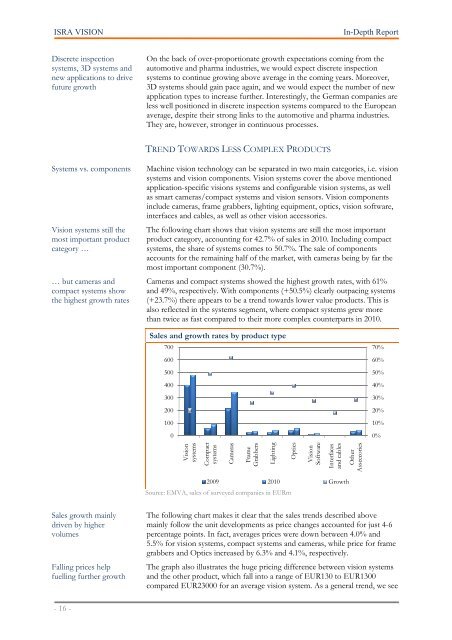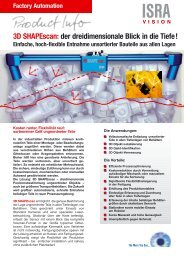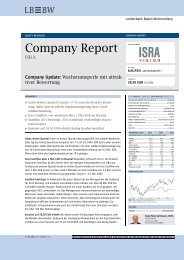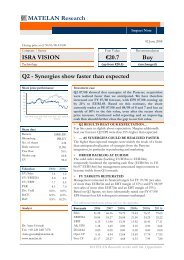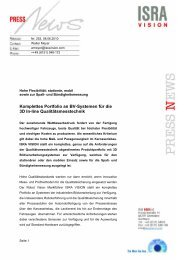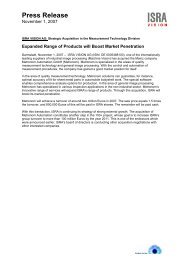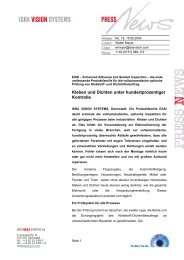MATELAN Research - ISRA VISION AG
MATELAN Research - ISRA VISION AG
MATELAN Research - ISRA VISION AG
You also want an ePaper? Increase the reach of your titles
YUMPU automatically turns print PDFs into web optimized ePapers that Google loves.
<strong>ISRA</strong> <strong>VISION</strong> In-Depth Report<br />
Discrete inspection<br />
systems, 3D systems and<br />
new applications to drive<br />
future growth<br />
Systems vs. components<br />
Vision systems still the<br />
most important product<br />
category …<br />
… but cameras and<br />
compact systems show<br />
the highest growth rates<br />
Sales growth mainly<br />
driven by higher<br />
volumes<br />
Falling prices help<br />
fuelling further growth<br />
- 16 -<br />
On the back of over-proportionate growth expectations coming from the<br />
automotive and pharma industries, we would expect discrete inspection<br />
systems to continue growing above average in the coming years. Moreover,<br />
3D systems should gain pace again, and we would expect the number of new<br />
application types to increase further. Interestingly, the German companies are<br />
less well positioned in discrete inspection systems compared to the European<br />
average, despite their strong links to the automotive and pharma industries.<br />
They are, however, stronger in continuous processes.<br />
TREND TOWARDS LESS COMPLEX PRODUCTS<br />
Machine vision technology can be separated in two main categories, i.e. vision<br />
systems and vision components. Vision systems cover the above mentioned<br />
application-specific visions systems and configurable vision systems, as well<br />
as smart cameras/compact systems and vision sensors. Vision components<br />
include cameras, frame grabbers, lighting equipment, optics, vision software,<br />
interfaces and cables, as well as other vision accessories.<br />
The following chart shows that vision systems are still the most important<br />
product category, accounting for 42.7% of sales in 2010. Including compact<br />
systems, the share of systems comes to 50.7%. The sale of components<br />
accounts for the remaining half of the market, with cameras being by far the<br />
most important component (30.7%).<br />
Cameras and compact systems showed the highest growth rates, with 61%<br />
and 49%, respectively. With components (+50.5%) clearly outpacing systems<br />
(+23.7%) there appears to be a trend towards lower value products. This is<br />
also reflected in the systems segment, where compact systems grew more<br />
than twice as fast compared to their more complex counterparts in 2010.<br />
Sales and growth rates by product type<br />
700<br />
600<br />
500<br />
400<br />
300<br />
200<br />
100<br />
0<br />
Vision<br />
systems<br />
Compact<br />
systems<br />
Cameras<br />
Frame<br />
Grabbers<br />
2009 2010 Growth<br />
Source: EMVA, sales of surveyed companies in EURm<br />
Lighting<br />
The following chart makes it clear that the sales trends described above<br />
mainly follow the unit developments as price changes accounted for just 4-6<br />
percentage points. In fact, averages prices were down between 4.0% and<br />
5.5% for vision systems, compact systems and cameras, while price for frame<br />
grabbers and Optics increased by 6.3% and 4.1%, respectively.<br />
The graph also illustrates the huge pricing difference between vision systems<br />
and the other product, which fall into a range of EUR130 to EUR1300<br />
compared EUR23000 for an average vision system. As a general trend, we see<br />
Optics<br />
Vision<br />
Software<br />
Interfaces<br />
and cables<br />
Other<br />
Asseccories<br />
70%<br />
60%<br />
50%<br />
40%<br />
30%<br />
20%<br />
10%<br />
0%


